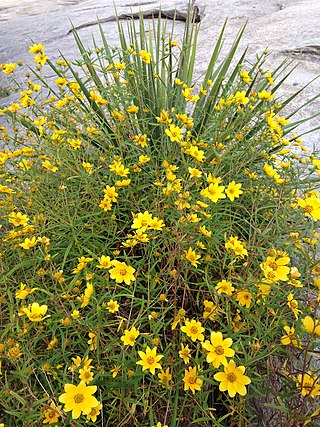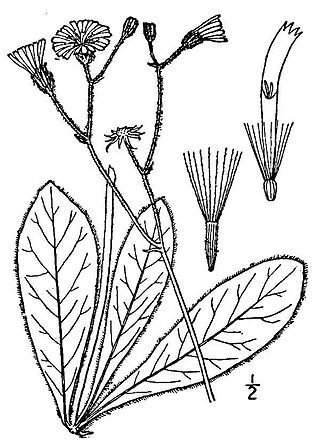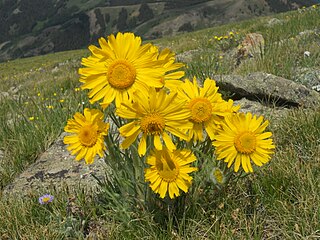
Coreopsis is a genus of flowering plants in the family Asteraceae. Common names include calliopsis and tickseed, a name shared with various other plants.

Hesperoyucca whipplei, the chaparral yucca, our Lord's candle, Spanish bayonet, Quixote yucca or foothill yucca, is a species of flowering plant closely related to, and formerly usually included in, the genus Yucca. It is native to southwest communities of North America.

Astragalus newberryi, is a flowering plant in the family Fabaceae, native to the western United States from Idaho to New Mexico and California. A variety is found in the Death Valley area and the eastern Mojave Desert in California and Nevada. It grows in rocky and gravelly areas between 1,300–2,350 metres (4,270–7,710 ft) elevation.

Hymenopappus is a genus of flowering plants in the daisy family. Many species are known as woollywhites.

Hymenopappus filifolius is a North American species of flowering plant in the daisy family known by the common names fineleaf hymenopappus and Columbia cutleaf. It is native to western and central North America from Alberta and Saskatchewan south as far as Chihuahua and Baja California.

Sclerocactus sileri, the Siler fishhook cactus, is a rare and very small cactus found mostly in mineral-rich desert areas of intermediate elevations, notably in the American states of Utah, Nevada, and northern Arizona.

Helianthus porteri is a species of sunflower known by the common names Porter's sunflower, Stone Mountain daisy and Confederate daisy. The term "daisy" is imprecise because the species is a sunflower (Helianthus) rather than a daisy. Likewise, although the plant grows on Stone Mountain, GA, its range extends well beyond. The connection to the Confederacy is through Stone Mountain which contains a confederate monument, although the connection is tenuous as the species was named before the Civil War in 1849 by Harvard botanist Asa Gray in honor of Thomas Conrad Porter, a Pennsylvanian minister and botanist who collected the plant in Georgia. Gray initially named the plant Rudbeckia porteri, later changed to Helianthus in 1998 by John F. Pruski.

Euthamia leptocephala, the bushy goldentop or Mississippi Valley goldentop, is a North American species of plants in the family Asteraceae. It is native to the south-central United States, in the lower Mississippi Valley and the Coastal Plain of the Gulf of Mexico, from Texas to west-central Georgia and north as far as southern Illinois.

Hieracium traillii is a species of hawkweed known by the common name Maryland hawkweed.

Hymenopappus artemisiifolius, the oldplainsman, is a North American species of flowering plant in the daisy family. It has been found only in the south-central United States, in Texas, Arkansas, and Louisiana. Its natural habitat is in sandy soils of prairies and open woodlands.
Hymenopappus biennis, the biennial woollywhite, is a North American species of flowering plant in the daisy family. It has been found in New Mexico and western Texas.
Hymenopappus carrizoanus, the Carrizo Sands woollywhite, is a North American species of flowering plant in the daisy family. It has been found only in Texas, on the Carrizo Sands of the central part of the state.
Hymenopappus flavescens, the collegeflower, is a North American species of flowering plant in the daisy family.
Hymenopappus flavomarginatus is a North American species of flowering plant in the daisy family.
Hymenopappus radiatus, the ray hymenopappus, is a North American species of flowering plant in the daisy family.

Hymenothrix wrightii, commonly known as Wright's hymenothrix or Wright's thimblehead, is a North American species of flowering plant in the daisy family. It grows in northwestern Mexico and the southwestern United States.

Hymenopappus scabiosaeus, the Carolina woollywhite, is a North American species of flowering plant in the daisy family. It grows in the central and southeastern United States, primarily on the Great Plains an on the Coastal Plain of the Southeast. There are also isolated populations in Illinois and Indiana as well as in the state of Coahuila in northern Mexico.
Hymenopappus tenuifolius, the Chalk Hill hymenopappus, is a North American species of flowering plant in the daisy family. It grows in the central and southeastern United States, primarily on the Great Plains from Texas and New Mexico north as far as South Dakota.
Hymenoxys brandegeei is a species of flowering plant in the daisy family known by the common names Brandegee's four-nerve daisy, Brandegee's rubberweed or western bitterweed. It is native to the states of Arizona, Colorado, and New Mexico in the southwestern United States.

Hymenoxys grandiflora is a North American species of flowering plant in the daisy family known by the common names graylocks four-nerve daisy, graylocks rubberweed, or old man of the mountain. It is native to high elevations in the Rocky Mountains of the western United States.













